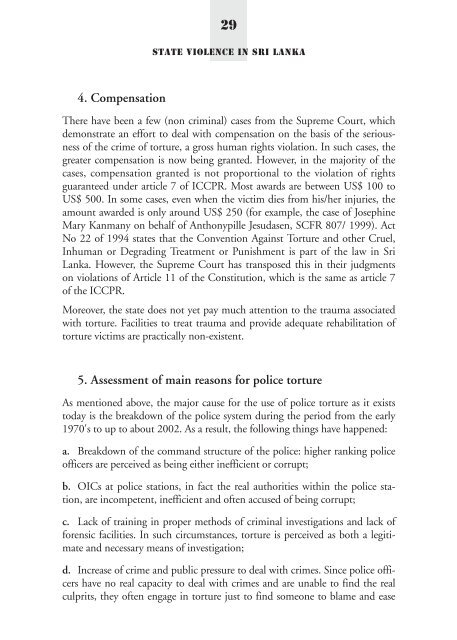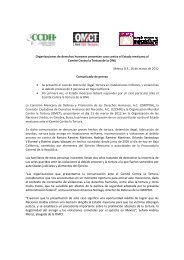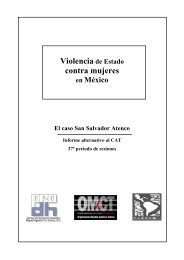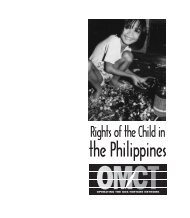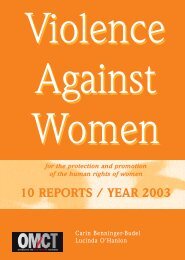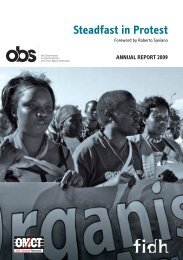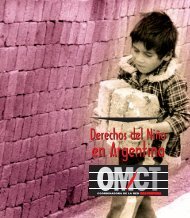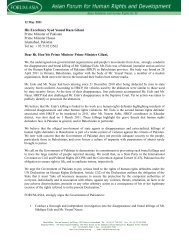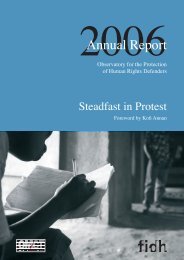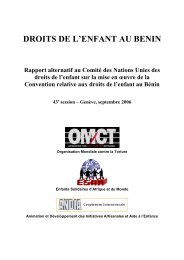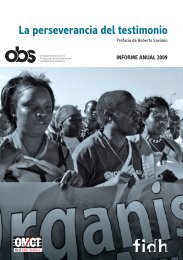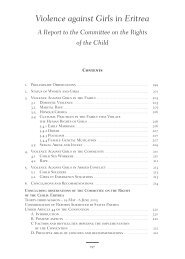State Violence in Sri Lanka - World Organisation Against Torture
State Violence in Sri Lanka - World Organisation Against Torture
State Violence in Sri Lanka - World Organisation Against Torture
Create successful ePaper yourself
Turn your PDF publications into a flip-book with our unique Google optimized e-Paper software.
29<br />
<strong>State</strong> <strong>Violence</strong> <strong>in</strong> SRI LANKA<br />
4. Compensation<br />
There have been a few (non crim<strong>in</strong>al) cases from the Supreme Court, which<br />
demonstrate an effort to deal with compensation on the basis of the seriousness<br />
of the crime of torture, a gross human rights violation. In such cases, the<br />
greater compensation is now be<strong>in</strong>g granted. However, <strong>in</strong> the majority of the<br />
cases, compensation granted is not proportional to the violation of rights<br />
guaranteed under article 7 of ICCPR. Most awards are between US$ 100 to<br />
US$ 500. In some cases, even when the victim dies from his/her <strong>in</strong>juries, the<br />
amount awarded is only around US$ 250 (for example, the case of Joseph<strong>in</strong>e<br />
Mary Kanmany on behalf of Anthonypille Jesudasen, SCFR 807/ 1999). Act<br />
No 22 of 1994 states that the Convention Aga<strong>in</strong>st <strong>Torture</strong> and other Cruel,<br />
Inhuman or Degrad<strong>in</strong>g Treatment or Punishment is part of the law <strong>in</strong> <strong>Sri</strong><br />
<strong>Lanka</strong>. However, the Supreme Court has transposed this <strong>in</strong> their judgments<br />
on violations of Article 11 of the Constitution, which is the same as article 7<br />
of the ICCPR.<br />
Moreover, the state does not yet pay much attention to the trauma associated<br />
with torture. Facilities to treat trauma and provide adequate rehabilitation of<br />
torture victims are practically non-existent.<br />
5. Assessment of ma<strong>in</strong> reasons for police torture<br />
As mentioned above, the major cause for the use of police torture as it exists<br />
today is the breakdown of the police system dur<strong>in</strong>g the period from the early<br />
1970's to up to about 2002. As a result, the follow<strong>in</strong>g th<strong>in</strong>gs have happened:<br />
a. Breakdown of the command structure of the police: higher rank<strong>in</strong>g police<br />
officers are perceived as be<strong>in</strong>g either <strong>in</strong>efficient or corrupt;<br />
b. OICs at police stations, <strong>in</strong> fact the real authorities with<strong>in</strong> the police station,<br />
are <strong>in</strong>competent, <strong>in</strong>efficient and often accused of be<strong>in</strong>g corrupt;<br />
c. Lack of tra<strong>in</strong><strong>in</strong>g <strong>in</strong> proper methods of crim<strong>in</strong>al <strong>in</strong>vestigations and lack of<br />
forensic facilities. In such circumstances, torture is perceived as both a legitimate<br />
and necessary means of <strong>in</strong>vestigation;<br />
d. Increase of crime and public pressure to deal with crimes. S<strong>in</strong>ce police officers<br />
have no real capacity to deal with crimes and are unable to f<strong>in</strong>d the real<br />
culprits, they often engage <strong>in</strong> torture just to f<strong>in</strong>d someone to blame and ease


